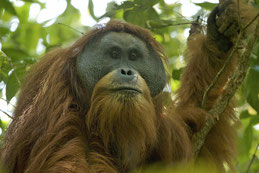The Orang Utan
Orang Utans are primates of the family of apes (Hominidae). They stand out due of their reddish-brown coat and their exceptionally long arms which enable them to adapt to the tree tops. Although they used to inhabit large areas in Asia, nowadays they can only be found on Sumatra and Borneo, but in the last decades their numbers have been decreasing at an alarming rate.
Today we distinguish three subspecies: the Borneo Orang Utan (Pongo pygmaeus), the Sumatran Orang Utan (Pongo abelii) and the recently discovered Tapanuli-Orang-Utan (Pongo tapanuliensis).
The name Orang Utan is composed by the malay words “orang” (human) and “Utan” (forest) so it basically means “man of the forest”.

In general Orang Utans are solitary animals, only the mothers and their babies stay together for several years. Nevertheless it might occur that some animals stay in groups for some time. Not all Orang Utans are sedentary; the males often do not have territories and roam around. Females in general do have their own territories which may consist of several hundred hectares.
Although the estimation for the total population is ± 120 000 animals, the species is considered to be critically endangered. This is mainly due to their extremely low reproduction rate: generally a female gives birth to only 2-3 babies in her whole life. This is considerably less than any other animal species!
The Orang Utan does is not the sole endangered species in Indonesia, it rather stands for an entire natural habitat that is extremely rich in animal species. On our site under “Other endangered species”, we present some other animals that are endangered and threatened by extinction for the same reasons as the Orang Utans.
Verkaufstände/Booths/events/stands de vente
2025
- Blummefest Kayl /11. Mai
- Helpermaart, Buschdorf / 8. Juni
- Eeneltermaart / 14.September
- Kropemannsfest / 28. September
- Cour de Justice UE /Dezember









